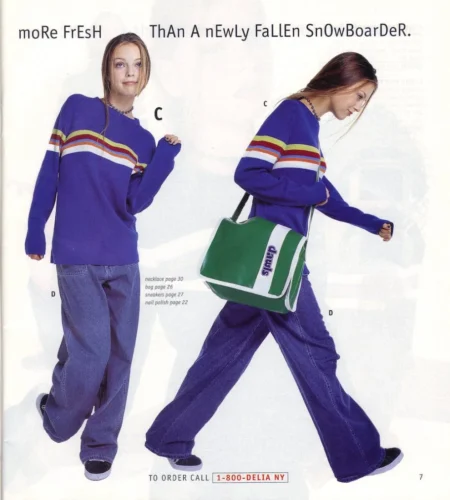(image credit: getty images)
For those of us who came of age in the 1990s, a time of relative peace and prosperity, several cultural benchmarks define our generation. It was the age of MTV and influential early music videos, the proliferation of pop culture, the first generation to have access to a computer or the internet in our own homes, and the height of suburban malls before their gradual decline. But for any young woman, the influence of the dELiA*s catalog was profound, to the extent that it could be featured in ethnographic research papers.

Delia’s Winter 1996
dELiA*s first launched in the pre-internet era, following in our mothers’ footsteps of mail-order catalogs (think Sears) but featuring aesthetically pleasing graphic designs, fun and whimsical fashion, and the promise of individuality and sisterhood. It was MTV, Girl Empowerment, and all our favorite rom-com 90s movies combined in print at accessible prices, with styles constantly changing and adapting to the latest trends. It was the voice of popular fashion, and somehow, it harnessed our mall-era culture and sent it directly to our homes. The catalog sold more than just fashionable outfits; it also sold a lifestyle. If it were personified today, dELiA*s would be a TikTok influencer with a fashion style we could reasonably afford. Just dial 1-800-DELIA-NY.

dELiA*s was ahead of its time in targeting a niche demographic group. In the early 90s, many of us had limited shopping options—either spending hours at a mall or sifting through our older cousins’ wardrobes. dELiA*s changed that, opening up a world of curated fashion that we could browse for hours, either alone or with friends, circling the pieces we would beg our parents for. The company initially intended to focus the catalog and its marketing efforts on college-aged women. However, it pivoted when it realized that older young women would be more able to access shopping and more likely to live in cosmopolitan centers. This redirect was a resounding success, with 55 million copies of its catalogs being delivered to homes at the company’s peak.

DELiA*s Spring Break 1998
While there is much to be said about the onslaught of commercial marketing campaigns that would soon come to dominate the perspectives, style, and self-image of young girls, dELiA*s was ahead of its time and never felt predatory. Maybe because we only received it in doses, we got to flip through the pages on our terms instead of being constantly barraged with imagery and stealth marketing. For those who grew up during this cultural phenomenon and are now parents today, fair to say we would probably much rather have our kids influenced by a seasonal analog catalog and aspire to be well, kids. So here is to the once-in-a-lifetime era of dELiA*s.


